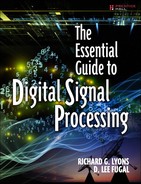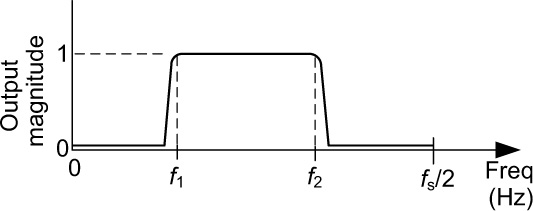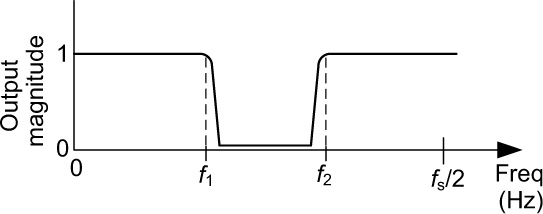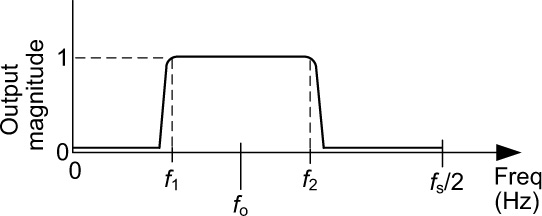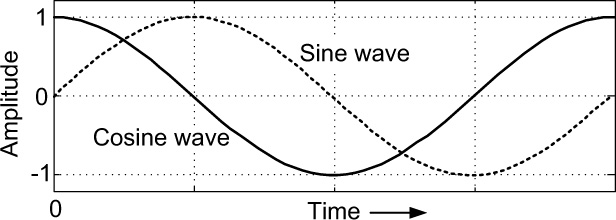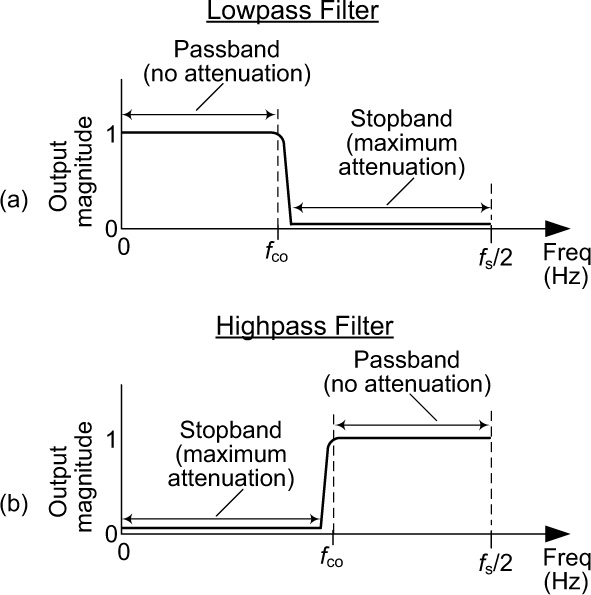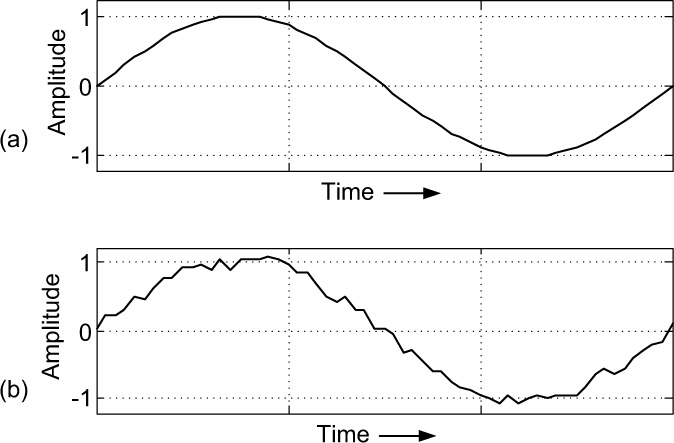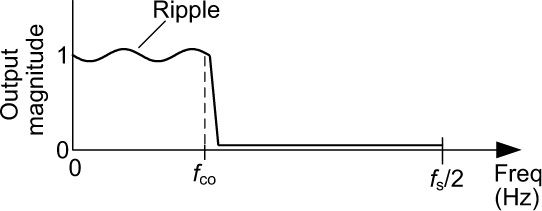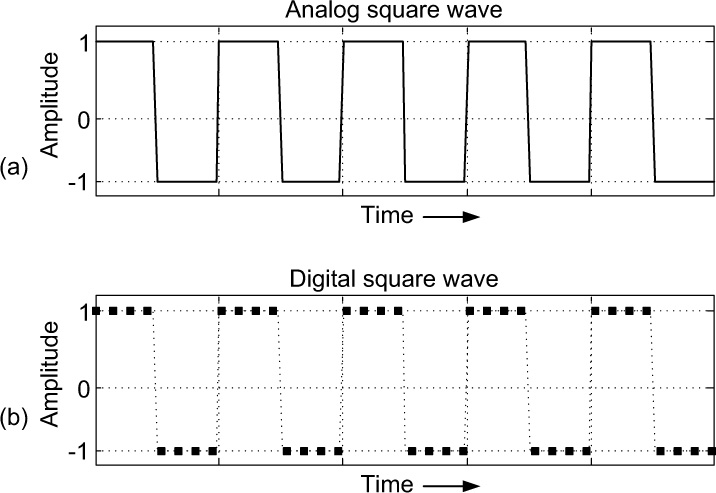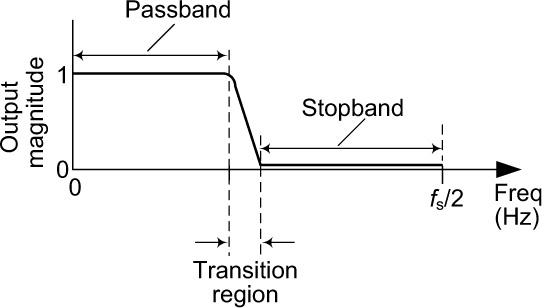Glossary
See alternating current.
See analog-to-digital converter.
A clearly defined sequence of mathematical steps performed on digital signals and used to perform a given signal processing objective. The processes of digital filtering and the discrete Fourier transform (DFT) are examples of algorithms.
The frequency of a high-frequency analog sine wave that, when sampled with an analog-to-digital converter, appears as a lower-frequency sine wave in the converted digital signal.
An undesirable effect that can occur when sampling an analog signal. Aliasing occurs when a high-frequency analog signal spectral component falsely appears as a low-frequency spectral component in the sampled digital signal. Aliasing is avoided if the sample rate of the analog-to-digital conversion is greater than twice the highest-frequency spectral component in the input analog signal (Nyquist sampling criterion).
A term used to describe an analog signal voltage whose amplitude fluctuates over time.
See amplitude modulation.
An electronic circuit, or electronic device, used to increase the amplitude (or power) of an analog signal.
The voltage at any instant in time of a time-domain analog voltage waveform indicating its instantaneous energy. Sometimes engineers use the word amplitude to describe the maximum positive value of a time-domain sinusoidal wave.
A radio communication method where the amplitude of a high-frequency sine wave is modulated (controlled) by the amplitude of a low-frequency audio signal. The high-frequency amplitude modulated sine wave can then be transmitted as an electromagnetic wave using an antenna. AM radio receivers are designed to receive and extract the audio signal from the amplitude-modulated radio wave.
A collection of interconnected electronic hardware components that transforms an analog voltage signal (the input) into another voltage signal (the output) having a modified frequency domain spectrum. See lowpass, bandpass, and highpass filters.
In contrast to a digital signal that is a sequence of discrete numbers, an analog signal is an information-carrying continuous signal (typically a voltage) that varies over time and can take on any value between its minimum and maximum values.
Analog-to-digital converter (ADC)
A hardware device that accepts, at its input, an analog voltage signal and produces a periodic stream of numbers. The numbers represent the value of the analog voltage at periodically spaced instants in time. The repetition rate of the instants in time is determined by the frequency (sample rate) of the periodic clock input to the converter.
An analog lowpass filter used to limit the bandwidth of an analog signal before that analog signal is applied to an analog-to-digital converter (ADC). Also used to describe an analog lowpass filter used to limit the bandwidth of an analog signal produced by a digital-to-analog converter (DAC).
An amplitude loss, usually measured in dB, incurred by a signal after passing through a digital filter. Filter attenuation is the ratio, at a given frequency, of the signal amplitude at the output of the filter divided by the signal amplitude at the input of the filter.
Describes signals whose frequency content is in the range of 50 Hz to 15 kHz. An audio voltage signal, applied to the terminals of a loudspeaker, will generate air pressure waves that can be heard as sound by human beings.
See moving averager.
A filter, as shown in Figure G-1, that passes one frequency band, from frequency f1 to frequency f2, and attenuates frequencies above and below that band.
A filter that rejects (attenuates) one frequency band, from frequency f1 to frequency f2, and passes both a lower- and a higher-frequency band. Figure G-2 depicts the frequency response of an ideal band reject digital filter.
The frequency range over which a signal contains significant spectral energy or the frequency width of the passband of a filter. See passband.
See binary number system.
Our familiar system of counting that has ten different digits, 0 through 9. Chapter 9 discusses the base-10 number system and other numbers systems used in digital signal processing.
A system of counting that has only two digits, 0 and 1. All of the arithmetic operations that we perform in our traditional decimal number system, such as addition, subtraction, multiplication, and division, can be performed in the binary number system. The binary number system is used because it is the most inexpensive and reliable way to perform arithmetic operations using electronic components.
A bit (short for Binary digIT) is the smallest unit of information in a binary number. A bit is a single binary digit of either 0 or 1.
The process of radiating an information-carrying analog electromagnetic signal using an antenna.
A sequence of 8 binary bits.
The frequency of the center of the bandwidth of a broadcasted radio signal.
The implementation of a filtering system where multiple individual filters are connected in a series. That is, the output of one filter drives the input of the following filter as illustrated in Figure G-3.
See compact disc.
Short for cellular phone: a mobile telephone.
The frequency located at the midpoint of a bandpass filter. Figure G-4 shows the fo center frequency of a bandpass filter. Center frequency is also used to specify the frequency located at the midpoint of a band of signal spectral energy.
Slang for a single integrated circuit.
An organized interconnection of electronic hardware devices that accomplishes an electrical objective.
A square wave voltage inside a hardware device containing digital signals, such as a computer or a cell phone, used to synchronize the operation of various electronic circuits.
A plastic disc with a thin metal surface on one side, 4.7 inches in diameter, used to store both binary digital data files as well as binary digital music signals. CDs are able to store 0.7 gigabits of binary data.
See analog signal.
A sinusoidal wave form whose initial value (at zero time) is shown by the solid-line curve in Figure G-5.
The upper passband frequency for lowpass filters, and the lower passband frequency for highpass filters. Figure G-6 illustrates the fco cutoff frequency of a lowpass filter.
The unit of measure for frequency.
See digital-to-analog converter.
See decibel.
Acronym for direct current. A long-standing technical term used to describe a signal (either an analog voltage or a discrete sequence of numbers) whose amplitude remains constant as time passes.
An analog voltage whose amplitude remains constant as time passes.
A unit of attenuation, or gain, used to express the relative voltage or power difference between two signals. Appendix B discusses decibels in detail.
The number system we use every day that includes 10 digits, 0, 1, 2, 3, ... 9.
Decreasing the sample rate of a digital signal.
See discrete Fourier transform.
A computational process, or algorithm, that transforms a discrete time-domain sequence of numbers (the input) into another discrete sequence of numbers (the output) having a modified frequency domain spectrum. See lowpass, bandpass, and highpass filters.
A number used, or displayed, by a piece of electronic hardware. The time shown on the face of a digital clock is a digital number, as are the numbers on a computer keyboard.
An information-carrying discrete sequence of numbers where each numerical value can only be one of a limited set of possible values. This is the predominate definition of digital signal used in this book. Also refers to an analog voltage inside electronic equipment that fluctuates between one of two voltage values.
The numerical processing of signal data samples.
An integrated circuit specifically designed to efficiently perform arithmetic operations on sequences of numerical signal data samples.
A hardware device that accepts, at its input, digital sample values and produces an output analog voltage signal.
A metallic disc, 4.7 inches in diameter, used to store both digital data files as well as digital music signals. DVDs are able to store 4.7 gigabits of binary data.
A long-standing technical term used to describe a signal (either an analog voltage or a discrete sequence of numbers) whose amplitude remains constant over time.
The mathematical process performed on digital signal sequences (the input) to produce a sequence of numbers representing the spectral (harmonic) content of those input time sequences.
See decimation.
See digital signal processing.
A specialized algorithm (a sequence of mathematical steps) to very efficiently perform discrete Fourier transforms (DFTs). By “efficiently” we mean with a drastically reduced number of mathematical operations, which is a very good thing indeed.
A hardware device (for analog signals) or arithmetic process (for digital signals), used to modify the spectral content of a time-domain signal.
Finite impulse response filter (FIR)
Defines a class of digital filters that have exactly linear-phase behavior.
See finite impulse response filters.
See frequency modulation.
A measure of how many complete cycles of a periodic wave repeat in the time period of one second. The typical units of measure of frequency are hertz (Hz). For convenience in mathematical analysis (algebra), frequency is sometimes measured in radians per second. See radians per second.
An adjective meant to specify the spectral content of a signal.
A radio communication method where the frequency of a high-frequency sine wave is modulated (controlled) by the amplitude of a low-frequency audio signal. The high-frequency FM sine wave can then be transmitted as an electromagnetic wave using an antenna. FM radio receivers are designed to receive and extract the audio signal from the frequency modulated radio wave.
A frequency domain description of how a filter interacts with input signals. The bold solid curve in Figure G-7(a) is the frequency response of a digital lowpass filter having a cutoff frequency of fco Hz. Figure G-7(b) depicts the frequency response of a digital highpass filter.
The amount of amplification accomplished by an amplifier circuit. For example, a gain of 4 means the amplifier output signal’s amplitude is four times as great as the input signal’s amplitude.
An acronym for gigabits, 1,073,741,824 bits of binary data.
An acronym for gigabytes, 1,073,741,824 bytes = 8 × 1,073,741,824 = 8,589,934,592 bits of binary data.
An acronym for the frequency of 1 gigahertz (1,000,000,000 cycles per second).
A point, or node, in an electrical circuit to which all voltages in the circuit are referred.
A type of FIR digital filter where the transition region is centered at one-quarter of the sampling rate, or fs/4. Due to their frequency domain symmetry, half-band filters are often used in decimation schemes because half their time domain coefficients are zero. This reduces the number of necessary multiplication operations needed to produce each filter output sample.
An inadvertent and undesirable modification of the shape of a time signal that produces unwanted spectral components in that time signal.
The undesirable spectral components in a time signal that cause an inadvertent distortion of the shape of the time signal. Also used to describe the high-frequency spectral components contained in periodic time signals (such as square or triangular waves).
See high-definition television.
A measure of frequency equivalent to cycles per second (oscillations per second).
A convenient way for computer programmers to represent binary numbers using digits other than a 1 or 0. See Appendix D.
An all-digital system for transmitting a TV signal with far greater resolution than the older analog TV signals. A high-definition television (HDTV) can display several resolutions (up to two million pixels versus an older television’s 360,000). HDTV uses 24 binary bits to define a pixel’s color, which provides improved color rendition.
A term used by audio enthusiasts that refers to high-quality audio sound. By high-quality we mean, for example, how the audio from an expensive FM stereo system sounds compares to the audio we hear over a cell phone.
A filter that passes high frequencies and attenuates low frequencies as shown in Figure G-7(b). We’ve all experienced a kind of highpass filtering in our living rooms. Notice what happens when we turn up the treble control (or turn down the bass control) on our home stereo systems. The audio amplifier’s normally flat frequency response changes to a kind of analog highpass filter giving us that sharp and tinny sound as the high-frequency components of the music are accentuated.
See infinite impulse response filter.
A digital filter’s time domain output sequence when the input is a single unity-valued sample (impulse) preceded and followed by zero-valued samples. A digital filter’s frequency domain response can be calculated by performing the discrete Fourier transform (DFT) of the filter’s time domain impulse response.
Infinite impulse response (IIR) filter
Defines a class of digital filters that are not guaranteed to be stable and always have nonlinear phase responses. Infinite impulse response (IIR) filters have a much steeper transition region roll-off (superior performance) than digital finite impulse response (FIR) filters.
Positive or negative whole numbers such as 23, –57, or 99.
A miniaturized collection of interconnected (integrated) transistors encapsulated in a small plastic or ceramic block.
Increasing the sample rate of a digital signal.
Industry-standard electronic image file compression method. JPEG stands for Joint Photographic Experts Group.
An acronym for kilobits, 1,024 bits of binary data.
An acronym for kilobytes, 1,024 bytes = 8 × 1,024 = 8,192 bits of binary data.
An acronym for the frequency of 1 kilohertz (1,000 cycles per second).
An acronym for kilosamples per second, the rate at which an analog signal can be sampled, measured in thousands of samples per second.
The rightmost bit in a binary word (sequence of binary bits).
A filter that exhibits a constant change in phase angle (degrees) over frequency. The resultant filter phase plot versus frequency is a straight line. As such, a linear phase filter’s group delay is a constant. In order to preserve the integrity of their information-carrying signals, linear phase is an important criteria for filters used in cell phones and other wireless systems.
A hardware device that converts an electrical voltage signal to air pressure waves (sound). Loudspeakers operate over the frequency range of 50 Hz to 15 kHz.
A filter that passes low frequencies and attenuates high frequencies as shown in Figure G-7(a). By way of an example, we experience lowpass filtering when we turn up the bass control (or turn down the treble control) on our home stereo systems, giving us that dull muffled sound as the low frequency components of the music are intensified.
An acronym for megabits, 1,048,576 bits of binary data.
An acronym for megabytes, 1,048,576 bytes = 8 × 1,048,576 = 8,388,608 bits of binary data.
An acronym for the frequency of 1 megahertz (1,000,000 cycles per second).
Slang for a single integrated circuit.
A hardware device that converts air pressure waves (sound) to an electrical voltage signal. Microphones operate over the frequency range of 50 Hz to 15 kHz.
For audio signals, mixing is the process of adding two or more signals to create a composite audio signal. For signals in the radio frequency range, mixing is the process of multiplying one signal by a second signal. This radio frequency mixing is used to produce AM broadcast radio signals.
The leftmost bit in a binary word (sequence of binary bits).
An arithmetically simple digital lowpass filtering process where a fixed number of successive input signal sample values are averaged to produce a sequence of filter output samples. See Chapter 8 for an example of a moving averager filtering process.
Industry-standard electronic video file compression method. MPEG stands for Motion Picture Experts Group.
An acronym for megasamples per second. The sample rate, with which an analog signal can be sampled, measured in millions of samples per second.
A sequence of 4 binary bits. (Half a byte.)
The uncontrollable amplitude fluctuations of a time-domain signal as shown in Figure G-8(b). Noise is random and carries no useful information. The presence of noise makes it difficult to measure important signal parameters, and it is typically considered to be undesirable.
A digital filter implementation where no filter output sample is retained for later use in computing a future filter output sample.
A digital signal processing rule that states: To avoid undesirable frequency aliasing (digital signal distortion), the sample rate of analog-to-digital conversion must be greater than twice the highest frequency spectral content in the input analog signal. Named in honor of American engineer Harry Nyquist. Also called the Shannon-Nyquist sampling theorem.
A convenient way for computer programmers to represent binary numbers using decimal digits other than a 1 or a 0. See Appendix D.
A method of using binary numbers to represent both positive and negative decimal numerical values.
A piece of electronic equipment that accepts analog voltages as inputs and displays those voltage waveforms as two-dimensional plots on a display screen. The vertical axis of the plot is voltage level and the horizontal axis of the display is time (seconds).
The frequency range over which a filter passes input signal energy as depicted in Figure G-7.
Fluctuations in the passband amplitude response of a filter, as shown in Figure G-9.
The period of time, measured in seconds, that it takes a periodic signal to complete one oscillation.
An analog, or digital, signal whose time-domain waveform repeats as time passes.
The difference in phase, at a particular frequency, between an input sine wave and the output sine wave at that frequency. The phase response, sometimes called phase delay, is usually depicted using a curve showing the filter’s phase shift versus frequency.
Short for picture element. A single point (or dot) of an image such as the image on a computer screen, digital camera photo, or television screen. A 5 megapixel digital camera takes pictures comprising 5,000,000 individual pixels (colored dots). Those pixels come together to form an image. See high-definition television.
A rectangular plastic or fiberglass board with conductive copper lines printed or etched on the board. Electronic components are mounted on the board and the conductive lines (traces) connect the components to form a working circuit. The motherboard in your home computer is a printed circuit board. Printed circuit boards avoid the need to hand-solder electric wires between electronic components as was done decades ago.
To limit the possible values of a number to a discrete set of values of a specified precision. For example, quantizing the numbers 17.3, –26.88, and 52.13 to integers means to convert those numbers to 17, –26, and 52. As related to analog-to-digital converters, quantization is the process whereby the continuous range of an analog input signal’s values is divided into nonoverlapping voltage subranges. When an input analog signal value resides within a given voltage subrange, the converter output provides the corresponding unique, discrete binary numerical value.
An angular measure of how often a periodic wave repeats in the time period of one second. Primarily used in mathematical analysis (algebra). One 360-degree cycle is equal to 2π radians. One radians is roughly equal to 57.2 degrees.
Ranges of frequency bands of radiated sinusoidal electromagnetic waves:
• ultra-low frequency (ULF): DC–30 Hz
• extremely low frequency (ELF): 30–300 Hz
• voice-grade channel (VGC): 300–3400 Hz
• very low frequency (VLF): 3–30 kHz
• very high frequency (VHF): 30–300 MHz
• ultra-high frequency (UHF): 300–3000 MHz
A digital filter implementation where current filter output samples are retained for later use in computing future filter output samples.
See radio frequency.
A single number, a single element, of a digital signal’s sequence of numbers. The word sampling refers to the process of converting an analog signal to a digital signal (a discrete sequence of numbers) using an analog-to-digital converter.
See sample rate.
The repetition rate, measured in Hz, of the clock used to initiate the conversion of an analog signal to a digital sequence of numbers by an analog-to-digital converter (ADC). The sample rate is the reciprocal of the time period between samples of a digital signal (a discrete sequence).
The process of either decreasing (by way of decimation) or increasing (by way of interpolation) the sample rate of a digital signal.
A convenient and precise way for engineers and scientists to write very large and very small numbers. Appendix A discusses scientific notation in detail.
A number equal to the ratio of the power of the desired signal divided by the power of an undesired random noise signal that may be contaminating the desired signal. The larger the signal-to-noise ratio value, the better. This number is often expressed in units of dB.
A method of using binary numbers to represent both positive and negative decimal numerical values.
A sinusoidal waveform whose initial value (at zero time) is zero as shown by the dashed-line curve in Figure G-5.
A generic term meaning either a sine wave or a cosine wave.
The frequency content of an analog or digital signal. The combination of sinusoidal waves of different frequencies that make up a signal.
The process of measuring the frequency content of an analog or digital signal.
Electronic equipment that accepts analog voltages as inputs and displays signal spectra as two-dimensional plots on a display screen. The vertical axis of the plot is signal power level and the horizontal axis of the display is frequency (Hz).
A bi-level time-domain waveform as shown in Figure G-10.
The band of frequencies attenuated by a digital filter. Figure G-7 shows the stopbands of a lowpass and a highpass filter.
The reduction in amplitude, at the output of a filter, of spectral components residing in the stopband of that filter. Stopband attenuation is typically measured in decibels as shown for a lowpass filter in Figure G-11. In that figure, the stopband attenuation is 40 decibels (dB), which means that the amplitudes of filter input spectral components in the stopband frequency range have been reduced by a factor of 100 (see Appendix B).
See stopband attenuation.
A transducer used to measure the rate of revolution, measured in revolutions per second (RPM), of a mechanical shaft.
An adjective meant to specify how a signal’s amplitude varies as time passes.
A thin strip of copper conductor deposited on a printed circuit board.
A communication device containing both a receiver and a transmitter. A cell phone is a transceiver.
A basic solid-state (silicon) control device that permits or prevents current flow between two electric terminals, based on the voltage or current delivered to a third terminal. Transistors can be used as high-speed switches, either turned on or turned off, or as amplifiers, as in guitar amplifiers.
The frequency range over which a filter’s frequency response transitions from the passband to the stopband. Figure G-12 illustrates the transition region of a lowpass filter. Transition region is sometimes called the transition band.
In the field of digital filtering, transversal filter is another name for an FIR filter. See finite impulse response filter.
A time-domain analog waveform as shown in Figure 2-11.
Two’s complement binary numbers
A method of using binary numbers to represent both positive and negative decimal numerical values.
A method of using binary numbers to represent positive decimal numerical values.
See interpolation.
The electric pressure, or potential difference, that causes current (electrons) to flow within an electric circuit. Current flow can do work for us, such as turn an electric motor or generate visible light using a lightbulb. There are two types of voltages: AC (alternating current) voltage, whose voltage amplitude varies as time passes, such as a sine or cosine wave voltage; and DC (direct current) voltage whose voltage amplitude remains constant, such as the voltage of a car battery.
Refers to any fluctuating curve shown in a two-dimensional plot having time displayed on the horizontal axis. For example, Figure 2-3(b) is a voltage waveform.
The number of bits in a binary word. For example, the binary data word 101101 has a word length of 6.
